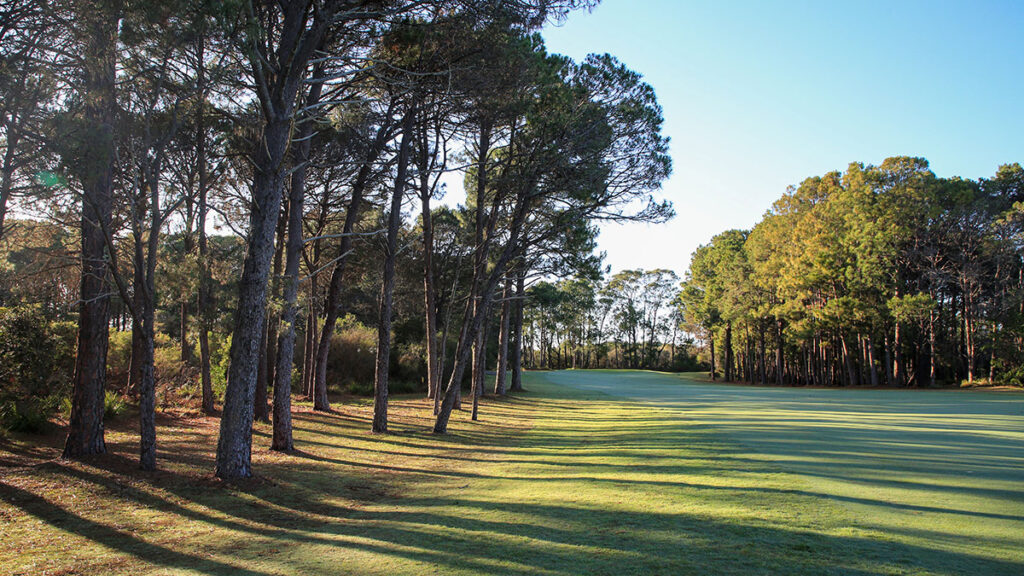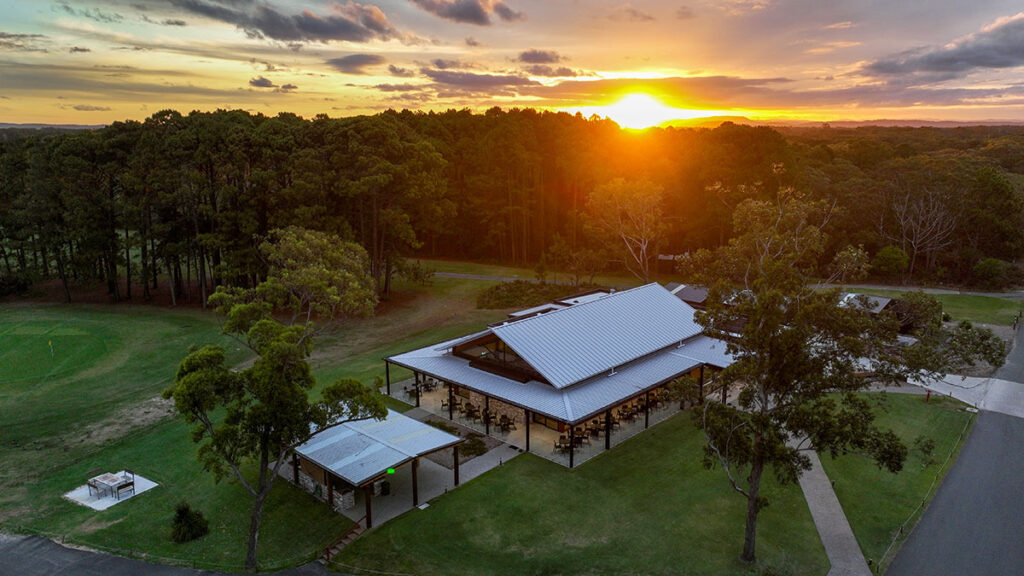Two for one: A pair of courses in separate locations but operating under one club, Forster Tuncurry is home to a rejuvenated, links-style layout coupled with a more user-friendly option in a bustling holiday haven
Photographs by Gary Lisbon
Golf clubs with 36 holes are rarities in Australia, and rarer still are clubs with multiple courses in different locations. One such setup is Forster Tuncurry Golf Club on the Mid-North Coast of New South Wales – a twin-course entity where the two courses are about seven kilometres apart by road.
The Forster course came first, opening in 1950 and set in the heart of the town, not far from One Mile Beach. It took until 1970 to evolve into the full 18 holes it is today. The Tuncurry course came later, not completed until 1984. It is clearly the superior layout, yet the 18 holes at Forster sees roughly equal golfer traffic. The beauty lies in the difference. Tuncurry is a strong test of golf, while the Forster course is short, largely open and more user-friendly. General manager Robin Taylor says that within the club’s membership, there are those who play only the Tuncurry course and another set who play exclusively at Forster, while the balance enjoy the playing experience at both venues. Different strokes for different folks.
In a popular holiday destination, the two courses collectively appeal to all. Hard-core golfers like to test their mettle at Tuncurry, while casual players flock to Forster. Tour groups and the organisers of amateur tournaments frequently book multi-day events to Forster Tuncurry because they appreciate the built-in variety.

The Kel Nagle/Mike Cooper-designed Tuncurry course is in peak condition these days thanks to a spirited vegetation management program led by course superintendent Mark Spraggs and design tweaks authored by Craig Parry. Every hole on the course is flanked on both sides by tea tree, banksias, melaleucas and other typically coastal scrub. Along with a few pine plantations and several huge gums, the Tuncurry layout was long known as much for its flora as for its fairways. Over time the playing corridors became suffocating and the layout more difficult as a result – probably unfairly so. In the mid-2000s, your correspondent played the course as part of a group who placed it in the dreaded ‘never to return’ category.
Thankfully, it’s very much the opposite scenario today. You wouldn’t skip Tuncurry while visiting the region. It’s most definitely worth the short diversion off the Pacific Highway and offers one of the best – and most improved – golf offerings in coastal NSW.
Parry first ventured to Tuncurry about five years ago, at the suggestion of fellow tour pro Steve Conran. Parry says he was “blown away” by the natural features of the layout, including the valleys, slopes and other undulations that are simply part of the land.
“One of the really, really unique things about playing Tuncurry is you never get the same lie when you hit it in the same place,” Parry says of the way the varied contours impact play. “Only the best courses in the world have that.
“There are so many components to that golf course that make it interesting. If they had the same number of ground staff as a Melbourne Sandbelt club, it’d be top-10 in the country.”
Another tour pro with Tuncurry ties is LPGA Tour veteran Sarah Kemp, whose parents moved to the area about 20 years ago. She enjoys the way the narrow fairways and small greens help hone her ball-striking.
“I like how it’s got a bit of character; it’s not just all straight-away,” Kemp adds. “One’s that little dogleg around to the right, two’s a little dogleg around to the left. There are straightforward holes, but it promotes working the ball. For a little country course, it’s nice that it demands a bit of moving the golf ball.”

Architecturally, Parry recommended enlarging three greens and adding five bunkers across four holes, yet more than anything the course breathes now. Clearing ground-level foliage helped promote airflow for better playing surfaces and improved playability without compromising the original design. Spraggs says they were careful not to remove the character of the golf course in their vegetation work and indeed the essence of Tuncurry remains. The difference is certainly visual, and golfers will notice the change immediately, but the enhanced playability is what will linger in memory after the round. Many holes feature one side where an escape is much more likely. There might be thick scrub and a no-go miss on one side, but invariably the opposite side of the fairway is lined by a single row of trees and so provides respite for an errant shot. I missed eight fairways in touring the 18 holes yet lost only one ball – and twice found and played balls that years ago would have been swallowed by the scrub.
One aspect not compromised in the work is the magnificent sense of isolation that most holes at Tuncurry afford golfers. Frequently, you feel as though you’re the only ones on the course – especially midway through the second nine where each fairway feels like its own little golf capsule. Some of the shrubbery was removed from the course, but not its soul.
“You can’t hear a car, which is really nice,” Kemp says. “It’s something that I really miss when I go over to the States. At Tuncurry, all I’m hearing is birds and the ocean when you get out closer to the waterside. Scenically, it’s an awesome spot – and calming.”
The course isn’t excessively bunkered, despite being blessed with a naturally sandy site. Many of the greens are raised with runoffs that complicate both approach shots and any subsequent misfires. The fine use of the natural contours is evident on holes like the par-4 sixth, where a spine in the fairway points golfers towards a small green set along the same ridgeline. At the par-5 15th, a series of ripples running across the fairway creates a wave-like effect.
The Tuncurry course is now a serious tournament venue, as evidenced by the NSW Women’s Open staged last March. A must-see feature is to wander through the small golf museum located in the clubhouse, which opened two years ago. The museum features an array of items and displays significant to the club but also to Australian golf and its golfers.

SHORT AND SWEET
Over at Forster, a new irrigation system installed in 2023 is starting to reap rewards, while the reworking of the course’s main water-storage dam and reshaping of the fairways surrounding it are helping facilitate improvements to the course. As with Tuncurry, Parry is assisting with design changes to strengthen the course in conjunction with course superintendent Ben Norton-Smith.
Holes one to 10 plus the 18th sit on the main part of the property and offer plenty of opportunities to flex some muscle and swing with freedom. The worst penalty a wild drive is likely to suffer there is an awkward approach angle over trees from an adjoining fairway. In contrast, the seven holes across the road on the back nine feature skinny fairways lined in many instances by rows of paperbarks and the tributaries of a nearby creek. This section of the course acts as a little microclimate for golfers that differs to the main ‘paddock’.

The 4,868-metre, par-66 Forster course isn’t likely to draw praise from golf-architecture buffs, yet it serves an important role as a fun and playable layout that works in tandem with its sister course. Small greens and precise targets mean it’s far from being a pushover; but it’s unlikely to require multiple sleeves of balls to play.
Forster and Tuncurry, two towns and two courses, both with unique attributes and wonderful overall points of difference. Together, they make for a potent 36-hole combo.
THE DETAILS
Forster Tuncurry Golf Club
Where: Strand St, Forster NSW 2428 and Northern Parkway, Tuncurry NSW 2428
Phone: (02) 6554 6799
Web: forstertuncurrygolf.com.au

